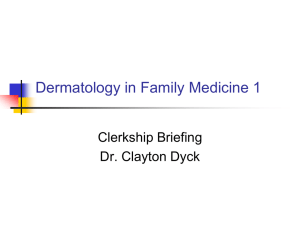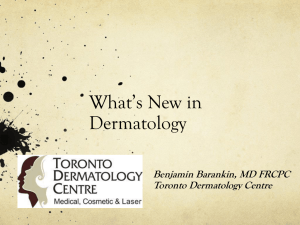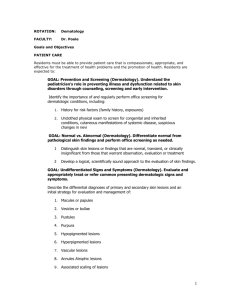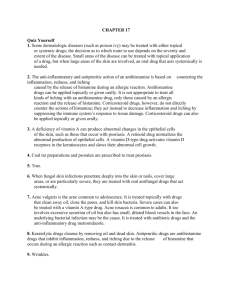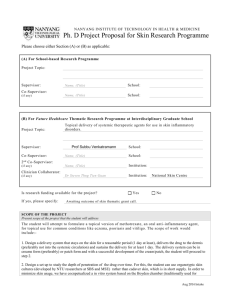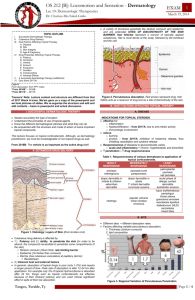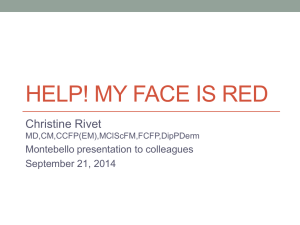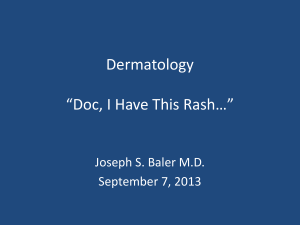Dermatologic Pharmacology
advertisement
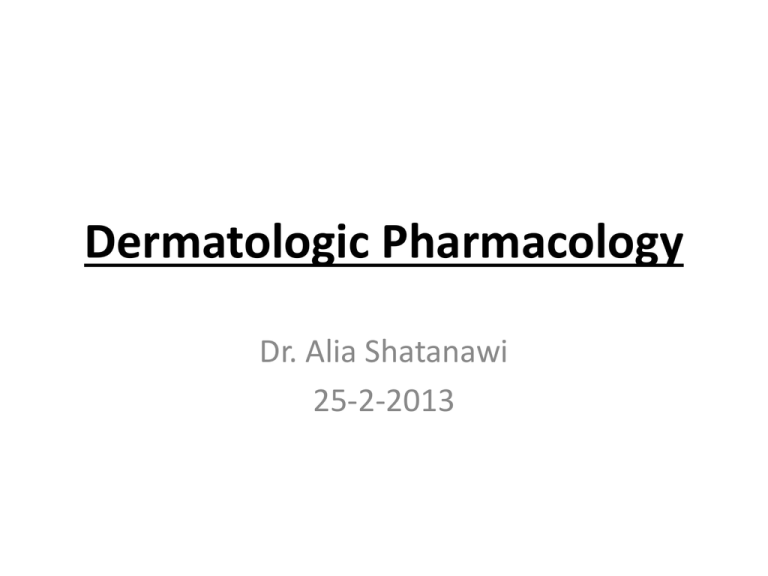
Dermatologic Pharmacology Dr. Alia Shatanawi 25-2-2013 Dermatologic Pharmacology Variables affecting Pharmacologic Response: • Regional variation in drug penetration • Concentration gradient: Increasing the concentration gradient increases the mass of drug transferred per unit time • • Dosing schedule Vehicles and occlusion Percutaneous Absorption. Dermatologic Formulations • • • • • • • • Tinctures Wet dressings Lotions Gels Powders Pastes Creams Ointments Adverse Effects of Dermatologic Preparations • Burning or stinging sensation • Drying and irritation • Pruritus • Erythema • Sensitization • Staining • Superficial erosion Topical Antibacterial Agents • Bacitracin. • Gramicidin. – Gram-positive bacteria. • Polymyxin B: • Neomycin. • Gentamicin. – Gram-negative bacteria. Bacitracin • Frequently used in combination with other agents (polymyxin B and neomycin) • Form: creams, ointments, and aerosol preparations • Usually Antiinflammatory agents added – (Hydrocortisone) Dr. Shatanawi 2012 Topical Antibacterials in Acne • • • • Clindamycin Erythromycin Metronidazole Sodium sulfacetamide Clindamycin • 10% absorbed, so, possibility of Pseudomembranous colitis • The hydroalcoholic vehicle and foam formulation (Evoclin) may cause drying and irritation of the skin, with complaints of burning and stinging. • The water-based gel and lotion formulations are well tolerated and less likely to cause irritation. Allergic contact dermatitis is uncommon. • Clindamycin is also available in fixed-combination topical gels with benzoyl peroxide (Acanya, BenzaClin, Duac), and with tretinoin (Ziana). Metronidazole • Eeffective in the treatment of rosacea. • The mechanism of action is unknown, but it may relate to the inhibitory effects of metronidazole on Demodex brevis; This drug may act as an anti-inflammatory agent by direct effect on neutrophil cellular function • Adverse local effects of the water-based gel formulation (MetroGel) include dryness, burning, and stinging. • Less drying formulations may be better tolerated (MetroCream, MetroLotion, and Noritate cream). • Caution should be exercised when applying metronidazole near the eyes to avoid excessive tearing. Erythromycin • In topical preparations, erythromycin base rather than a salt is used to facilitate penetration • One of the possible complications of topical therapy is the development of antibiotic-resistant strains of organisms, including staphylococci • Adverse local reactions to erythromycin solution may include a burning sensation at the time of application and drying and irritation of the skin • Erythromycin is also available in a fixed combination preparation with benzoyl peroxide (Benzamycin) for topical treatment of acne vulgaris. Topical Antifungal Agents • Azole Derivatives: – Clotrimazole – Econazole. – Ketoconazole. – Miconazole. – Oxiconazole. – Sulconazole. • Activity against dermatophytes and yeasts, including Candida albicans. Oral Antifungal Agents • Azole Derivatives: – Fluconazole. – Itraconazole. – Ketoconazole. • Affect the permeability of fungal cell membrane through alteration of sterol synthesis. • Effective in systemic mycosis, mucocutaneous candidiasis, and other cutaneous infections. • Might have systemic side effects: hepatitis and liver enzyme elevations, and interactions. Topical Antifungal Agents • Ciclopirox Olamine: Tinea versicolor • Naftifine and Terbinafine: tinea pedis, tinea cruris, and tinea corporis • Tolnaftate • Nystatin and Amphotericin B: – Only for Candida albicans. – Available as topical preparations, oral suspension, or vaginal tablets Oral Antifungal Agents • Azole Derivatives. • Griseofulvin: – Effective against epidermophyton, microsporum, and trichophton. – Requires prolonged treatment: • • • • 4-6 weeks for the scalp. 6 months for fingernails. 8-18 months for toenails. Has many side effects. • Terbinafine: – Recommended for onchomycosis (ringworm of the nail) • 6 weeks for fingernails. • 12 weeks for toenails. Topical Antiviral Agents • • • • Acyclovir. Valacyclovir. Penciclovir. Famciclovir. – Synthetic guanine analogs with inhibitory activity against herpes viruses. – Ointments and creams are useful for recurrent orolabial herpes simplex infection Immunomodulators • Imiquimod: – For external genital and perianal warts. – Actinic keratosis on the face and scalp. – Primary basal cell carcinoma. – Stimulates peripheral mononuclear cells to release interferon- ά and to stimulate macrophages to produce interleukins-1,-6, and -8 and tumor necrosis factor-ά. • Tacrolimus. • Pimecrolimus. – Useful for atopic dermatitis. – Inhibit T-lymphocyte activation and prevent release of inflammatory cytokines and mast cell mediators Ectoparasiticides • Permethrin: – Toxic to Pediculus humanus, Pthirus pubis, and Sarcoptes scabiei – Pediculosis:cream applied for 10 minutes and then rinsed off with warm water. – Scabies: cream applied for the whole body for 8-14 hours. • Lindane (Hexachlorocyclohexane): – 10% absorbed and concentrated in fatty tissues. – Can cause neurotoxicity and hematoxicity • Crotamiton: drug that is used both as a scabicidal (for treating scabies) and as a general antipruritic • Sulfur. • Malathion. Agents affecting Pigmentation • Hydroquinone: topical application skin whitening to reduce the color of skin • Monobenzone Monobenzone may be toxic to melanocytes resulting in permanent depigmentation. • Mequinol – Topical hydroquinone and mequinol usually result in temporary lightening. • Reduce hyperpigmentation of skin by inhibiting the enzyme tyrosinase which will interfere with biosynthesis of melanin Agents affecting Pigmentation • Trioxsalen. • Methoxsalen. – Are psoralens used for the repigmentation of depigmented macules of vitiligo. – Must be photoactivated by long-wave-length ultraviolet light (320-400nm) to produce a beneficial effect. – They intercalate with DNA. – Can cause cataract and skin cancer. Sunscreens and Sunshades • Sunscreens absorb UV light. – Examples are para amino benzoic acid (PABA) and its esters. • Sunshades are opaque materials that reflect light, like titanium dioxide. • Useful in polymorphous light eruption, lupus erythematosus, and drug –induced photosensitivity. Acne Preparations • Retinoic Acid and Derivatives: – Retinoic Acid. – Adapalene. – Tazarotene. Acne Preparations • Retinoic Acid and Derivatives: – Retinoic Acid( Tretinoin): is the acid form of Vitamin A. Stabilizes lysosomes, increases RNA polymerase activity, increases PGE2, cAMP, and cGMP levels, and increases the incorporation of thymidine into DNA. – Decreases cohesion between epidermal cells and increases epidermal cell turnover. This will result in expulsion of open comedones and the transformation of closed comedones into open ones. – Also, promotes dermal collagen synthesis, new blood vessel formation, and thickening of the epidermis, which helps diminish fine lines and wrinkles. – Can cause erythema and dryness. – Tumerogenic in animals Acne Preparations • Isotretinoin( Accutane): – Restricted for severe cystic acne resistant to standard treatment. – Inhibits sebaceous gland size and function. – Given orally: 1–2 mg/kg, given in two divided doses daily for 4–5 months – Toxic: dryness, itching, headache, corneal opacities, pseudotumor cerebri, inflammatory bowel disease, anorexia, alopecia, and muscle and joint pains. Also lipid abnormalities. – Teratogenicity Acne Preparations • Benzoyl Peroxide: – Penetrates the stratum corneum or follicular openings and converted to benzoic acid within the epidermis and dermis. – Has antimicrobial activity against P. acnes and peeling and comedolytic effects. – Can be combined with erythromycin or clindamycin. – Can cause bleaching of hair or colored fabrics. • Azelaic Acid: – Has antimicrobial activity. Drugs for Psoriasis • Acitretin: – Related to isotretinoin. – Given orally. – Hepatotoxic and teratogenic. – Patients should not become pregnant for 3 years after stopping treatment, and also should not donate blood. Drugs for Psoriasis • Tazarotene: – Topical. – Anti-inflammatory and antiproliferative actions. – Teratogenic. Also, can cause burning, stinging, peeling, erythema, and localized edema of skin. • Calcipotiene: – Synthetic vitamin D3 derivative Drugs for Psoriasis • Biologic Agents: – Alefacept: • Immunosuppressive dimer fusion protein of CD2 linked to the Fc portion of human IgG1. – Efalizumab: • Recombinant humanized IgG1 monoclonal antibody. • Withdrawn :progressive multifocal leukoencephalopathy (PML), • Can cause thrombocytopenia. – Etanercept: • Dimeric fusion protein of TNF receptor linked to the Fc portion of human IgG1. Anti-inflammatory Agents • Topical Corticosteroids: – Hydrocortisone. – Prednisolone and Methylprednisolone. – Dexamethasone and Betamethasone. – Triamcinolone. – Fluocinonide. Anti-inflammatory Agents • Topical Cortcosteroids: – Dermatologic disorders very responsive to steroids: • Atopic dermatitis. • Seborrheic dermatitis. • Lichen simplex chronicus. • Pruritus ani. • Allergic contact dermatitis. • Eczematous dermatitis. • Psoriasis Anti-inflammatory Agents • Topical Cortcosteroids: – Adverse Effects: • Suppression of pituitary-adrenal axis. • Systemic effects. • Skin atrophy. • Erythema. • Pustules. • Acne. • Infections. • Hypopigmentation. • Allergic contact dermatitis. Anti-inflammatory Agents • Topical Cortcosteroids. • Tar compounds: – Mainly for psoriasis, dermatitis, and lichen simplex chronicus – Can cause irritant folliculitis, phototoxicity, and allergic contact dermatitis. Keratolytic and Destructive Agents • Salicylic acid: – Solubilizes cell surface proteins resulting in desquamation of keratotic debris. – Keratolytic in 3-6% concentration, but destructive in higher concentrations. – Locally, can cause urticaria, anaphylactic and erythema multiforme reactions, irritation, inflammation, and ulceration. Keratolytic and Destructive Agents • Propylene Glycole: – Usually used as a vehicle for organic compounds. – Used alone as a keratolytic agent in concentrations of 40%- 70%, with plastic occlusion, or in gel with 6% salicylic acid. – Minimally absorbed, oxidized in liver to lactic acid and pyruvic acid. – Develops an osmotic gradient through the stratum corneum, thereby increasing hydration of the outer layers of skin. Keratolytic and Destructive Agents • Urea: – Has a humectant activity, i.e. softening and moisturizing effect on the stratum corneum. – Increases water content as a result of its hygroscopic characteristics. – Decreases the unpleasant oily feel of dermatologic preparations. – When absorbed, it is excreted in urine. Keratolytic and Destructive Agents • Flurouracil: – Antimetabolite that resembles uracil and inhibits thymidylate synthetase, thus interferes with DNA and may be RNA synthesis. – Used in multiple actinic keratosis. Keratolytic and Destructive Agents • Nonsteroidal Anti-inflammatory Drugs: – 3% gel formulation diclofenac. • Aminolevulinic Acid: – Used in actinic keratosis. – After topical application(20%) and exposure to light, produces a cytotoxic superoxide and hydroxyl radicals Antipruritic Agents • Doxepine: – Potent H1 and H2 – receptor antagonist. – Can cause drowsiness and anticholinergic effects. • Pramoxine: – Is a topical local anesthetic agent. Trichogenic and Antitrichogenic Agents • Minoxidil (Rogaine): – Designed as an antihypertensive agent. – Effective in reversing the progressive miniaturization of terminal scalp hairs associated with androgenic alopecia. – Vertex balding is more responsive than frontal balding. Trichogenic and Antitrichogenic Agents • Minoxidil. • Finasteride (Propecia): – 5ά-reductase inhibitor which blocks the conversion of testosterone to dihydrotestosterne. – Oral tablets. – Can cause decreased libido, ejaculation disorders, and erectile dysfunction. Trichogenic and Antitrichogenic Agents • Minoxidil. • Finasteride. • Eflornithine: – Is an irreversible inhibitor of ornithine decarboxylase, therefore, inhibits polyamine synthesis. Polyamines are important in cell division and hair growth. – Effective in reducing facial hair growth in 30% of women when used for 6 months.



